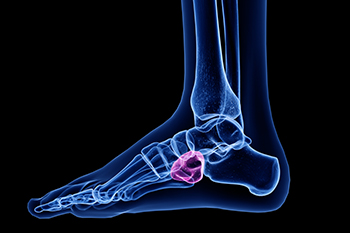Call Us Today! (203) 975-9600
SAME DAY APPOINTMENTS AVAILABLE
Where Is the Cuboid Bone Located?
Tuesday, 05 April 2022 00:00 The cuboid bone is one of seven tarsal bones that are located in the foot. This particular bone is found on the outside of the foot, near the front of the ankle, and this is where pain is felt when the cuboid bone becomes dislocated. It can happen as a result of enduring a break or sprain, and it often causes pain and discomfort. Relief may be found when the affected area is massaged, and a podiatrist may manipulate the cuboid bone back into its normal position. Some patients find it beneficial to wear specific shoes that can help the foot to feel better, in addition to taping the foot for stability. If you have pain in this part of your foot, it is strongly suggested that you speak with a podiatrist as quickly as possible who can offer you correct treatment solutions for cuboid syndrome.
The cuboid bone is one of seven tarsal bones that are located in the foot. This particular bone is found on the outside of the foot, near the front of the ankle, and this is where pain is felt when the cuboid bone becomes dislocated. It can happen as a result of enduring a break or sprain, and it often causes pain and discomfort. Relief may be found when the affected area is massaged, and a podiatrist may manipulate the cuboid bone back into its normal position. Some patients find it beneficial to wear specific shoes that can help the foot to feel better, in addition to taping the foot for stability. If you have pain in this part of your foot, it is strongly suggested that you speak with a podiatrist as quickly as possible who can offer you correct treatment solutions for cuboid syndrome.
Cuboid syndrome, also known as cuboid subluxation, occurs when the joints and ligaments near the cuboid bone in the foot become torn. If you have cuboid syndrome, consult with one of our podiatrists from Preferred Footcare, LLC. Our doctors will assess your condition and provide you with quality foot and ankle treatment.
Cuboid syndrome is a common cause of lateral foot pain, which is pain on the outside of the foot. The condition may happen suddenly due to an ankle sprain, or it may develop slowly overtime from repetitive tension through the bone and surrounding structures.
Causes
The most common causes of cuboid syndrome include:
- Injury – The most common cause of this ailment is an ankle sprain.
- Repetitive Strain – Tension placed through the peroneus longus muscle from repetitive activities such as jumping and running may cause excessive traction on the bone causing it to sublux.
- Altered Foot Biomechanics – Most people suffering from cuboid subluxation have flat feet.
Symptoms
A common symptom of cuboid syndrome is pain along the outside of the foot which can be felt in the ankle and toes. This pain may create walking difficulties and may cause those with the condition to walk with a limp.
Diagnosis
Diagnosis of cuboid syndrome is often difficult, and it is often misdiagnosed. X-rays, MRIs and CT scans often fail to properly show the cuboid subluxation. Although there isn’t a specific test used to diagnose cuboid syndrome, your podiatrist will usually check if pain is felt while pressing firmly on the cuboid bone of your foot.
Treatment
Just as the range of causes varies widely, so do treatments. Some more common treatments are ice therapy, rest, exercise, taping, and orthotics.
If you have any questions, please feel free to contact our office located in Stamford, CT . We offer the newest diagnostic and treatment technologies for all your foot care needs.
Call Us Today! (203) 975-9600
SAME DAY APPOINTMENTS AVAILABLE








